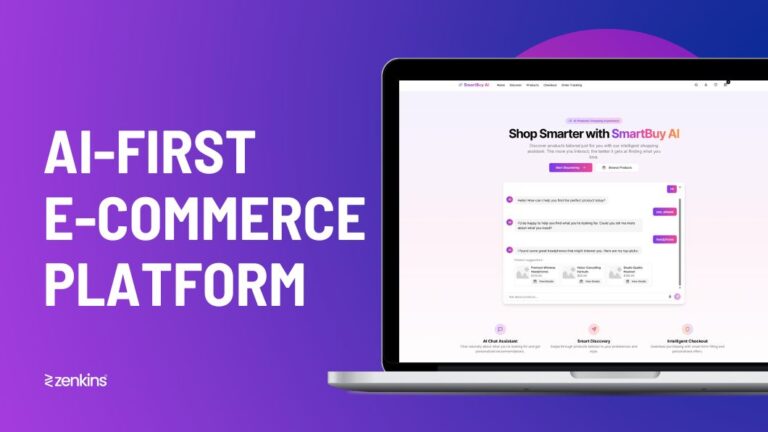Supervisory Control and Data Acquisition Application: A Case Study
Table of Contents
Case Study: SCADA Application Development for Industrial Automation
Client Overview:
The client is a leading industrial automation company specializing in providing advanced control systems for manufacturing and utility sectors. They required a robust Supervisory Control and Data Acquisition (SCADA) application to monitor and control industrial processes, ensuring real-time data collection, analysis, and operational efficiency.
Project Overview:
The client needed a scalable, secure, and high-performance SCADA application that could handle large volumes of data from various industrial sensors and control devices. The application needed to support real-time data processing, visualization, and remote control capabilities. Zenkins was engaged to develop the solution using .NET Core and related technologies to meet these complex requirements.
Objectives:
- Develop a user-friendly SCADA application with real-time data monitoring and control capabilities.
- Ensure high availability and scalability to handle large datasets and concurrent users.
- Implement advanced security measures to protect sensitive industrial data.
- Provide seamless integration with existing industrial hardware and software systems.
- Enable remote access for monitoring and controlling industrial processes from any location.
Solution Approach:
1. Technology Stack:
- Backend: .NET Core for developing a scalable and high-performance backend, capable of handling real-time data processing.
- Frontend: Angular for creating a responsive and intuitive user interface, enabling real-time data visualization and user interactions.
- Database: SQL Server for reliable data storage and management, supporting complex queries and large datasets.
- Communication Protocols: Implemented industry-standard protocols like Modbus, OPC UA, and MQTT for seamless integration with industrial hardware.
- Cloud Integration: Azure services were used for cloud deployment, enhancing scalability, and enabling remote access and control features.
2. Application Architecture:
- Microservices Architecture: Utilized a microservices approach to ensure modularity, allowing each component of the SCADA system (data acquisition, processing, visualization, and control) to be independently developed, deployed, and scaled.
- Real-Time Data Processing: Integrated SignalR for real-time communication between the server and client, enabling live data updates and notifications.
- Security: Implemented advanced security protocols, including OAuth 2.0 for secure user authentication, encryption of data in transit and at rest, and robust role-based access control (RBAC).
3. Key Features:
- Real-Time Monitoring: Provided dashboards with real-time data visualization, including charts, graphs, and alerts for process anomalies.
- Data Logging and Analysis: Implemented extensive data logging for historical analysis, helping users to identify trends and optimize operations.
- Remote Control: Enabled remote control of industrial processes, allowing users to adjust parameters and control devices directly from the application.
- Scalability: Designed the system to handle thousands of data points per second, ensuring smooth operation even under heavy loads.
- Custom Alerts and Notifications: Set up custom alerts for critical events, such as equipment failures or process deviations, delivered via email and SMS.
Implementation Challenges:
- Handling High-Volume Data Streams: Managing large volumes of data from numerous sensors required optimizing data processing and storage to prevent latency and ensure real-time performance.Solution: Implemented data partitioning and load balancing strategies, and optimized database queries to handle high-volume data streams efficiently.
- Ensuring Robust Security: Protecting sensitive industrial data from cyber threats was paramount.Solution: Applied comprehensive security measures, including encrypted communications, secure API endpoints, and continuous security testing to identify and address vulnerabilities.
- Integration with Legacy Systems: Integrating the new SCADA application with the client’s existing industrial hardware and legacy software posed challenges.Solution: Developed custom adapters and middleware to bridge the gap between modern software and older hardware, ensuring seamless communication and data exchange.
Results:
- Increased Efficiency: The SCADA application streamlined monitoring and control processes, reducing manual interventions and increasing operational efficiency by 30%.
- Enhanced Decision-Making: Real-time data analytics and visualization enabled the client to make informed decisions promptly, reducing downtime and optimizing resource utilization.
- Scalability and Flexibility: The modular architecture allowed easy scalability and adaptability to future needs, including the addition of new sensors and devices without significant rework.
- Improved Security: The application met all industry security standards, safeguarding the client’s data against unauthorized access and cyber threats.
Project Timeline and Phases:
Project Timeline: The project was completed over a period of six months, divided into key phases to ensure a structured and efficient development process.
Phases:
- Discovery and Planning (2 weeks): Understanding the client’s requirements, defining the project scope, and preparing a detailed project plan.
- Design Phase (3 weeks): Creating the system architecture, wireframes, and user interface design. This phase also involved selecting the technology stack and finalizing integration points with existing systems.
- Development Phase (3 months): Developing the backend using .NET Core, front-end with Angular, and setting up the database with SQL Server. This phase followed an iterative approach with weekly sprints.
- Testing Phase (4 weeks): Conducting rigorous testing, including unit testing, integration testing, and performance testing, to ensure the application met all functional and non-functional requirements.
- Deployment and Training (2 weeks): Deploying the SCADA application on Azure, setting up the cloud environment, and conducting user training sessions to facilitate smooth adoption.
- Post-Launch Support (1 month): Providing post-launch support, monitoring performance, and addressing any initial issues that arose after deployment.
Team Composition and Roles:
The project team comprised skilled professionals, each bringing specialized expertise to ensure the successful delivery of the SCADA application.
- Project Manager: Coordinated the project, managed timelines, and acted as the primary liaison between the client and development team.
- Lead .NET Developer: Led the backend development, ensuring the application met performance and scalability requirements.
- Front-End Developer: Developed the user interface using Angular, focusing on creating a responsive and intuitive user experience.
- Database Administrator: Managed the database design, optimization, and data security protocols.
- QA Engineers: Conducted comprehensive testing, including manual and automated tests, to ensure the application’s reliability and performance.
- DevOps Engineer: Handled the deployment on Azure, set up CI/CD pipelines, and managed infrastructure as code.
- UI/UX Designer: Designed user-friendly interfaces and ensured the application’s usability aligned with client expectations.
Tools and Methodologies:
Development Methodology:
The team adopted the Agile methodology, utilizing Scrum for iterative development and continuous feedback. This approach allowed for flexibility, regular client interactions, and adjustments based on evolving requirements.
Tools Used:
- Version Control: Git was used for source code management, enabling collaboration and version tracking.
- CI/CD: Azure DevOps facilitated continuous integration and continuous deployment, automating builds, tests, and deployments.
- Monitoring: Azure Monitor and Application Insights were used for performance monitoring, logging, and diagnostics.
- Collaboration: Tools like Jira for task management, Slack for team communication, and Confluence for documentation ensured seamless collaboration among team members.
Testing and Quality Assurance:
Testing Approach:
- Unit Testing: Each module was subjected to unit testing to validate individual components, ensuring they performed as expected in isolation.
- Integration Testing: Integration testing was carried out to verify the seamless interaction between the various components of the application.
- Performance Testing: Load testing and stress testing were conducted to evaluate the application’s performance under peak loads, ensuring it could handle the expected volume of data and users.
- User Acceptance Testing (UAT): Conducted with key stakeholders to validate the application against business requirements and ensure it met the client’s expectations before final deployment.
Quality Metrics:
- High code coverage was achieved through automated tests, ensuring robust application performance.
- Bugs identified during testing were tracked and resolved promptly, leading to a defect leakage rate of less than 2%.
Performance Metrics and Results:
The SCADA application demonstrated significant performance improvements across key metrics:
- Response Time: Achieved an average response time of less than 500 milliseconds for data retrieval and display, significantly improving operator efficiency.
- Data Throughput: The system was capable of processing over 50,000 data points per second, handling the client’s high-volume data streams without latency.
- Availability: The application maintained an uptime of 99.98%, ensuring reliable access for users.
- Operational Efficiency: Automated alerts and remote control functionalities reduced manual interventions by 30%, leading to more efficient process management and reduced downtime.
Future Enhancements and Roadmap:
Planned Enhancements:
- Predictive Analytics: Integration of machine learning models to predict equipment failures and optimize maintenance schedules, enhancing operational reliability.
- Mobile Access: Development of a mobile-friendly version of the application to allow operators and managers to monitor and control processes on the go.
- Enhanced Data Visualization: Adding more advanced visualization tools, including 3D modeling and augmented reality overlays, to provide deeper insights into complex data.
Scalability Plans:
- Expanding to New Sites: Plans to scale the solution to additional facilities, leveraging the cloud infrastructure to replicate the SCADA setup with minimal configuration changes.
- Integration with New Devices: Preparing the system to integrate with newer types of sensors and industrial devices as they are deployed in the client’s environment.
Lessons Learned and Best Practices:
Lessons Learned:
- Early Engagement with End Users: Engaging end users early in the design process provided valuable insights into real-world needs and helped tailor the application to be more user-friendly and practical.
- Importance of Scalability Planning: Designing the application with scalability in mind from the outset proved crucial in handling the client’s growing data needs without requiring significant rework.
- Security as a Continuous Process: Regular security audits and incorporating security into every phase of the development ensured the application met stringent security standards from the start.
Best Practices:
- Agile and Iterative Development: Using Agile practices allowed for continuous feedback and incremental improvements, leading to a product that closely aligned with the client’s evolving requirements.
- Robust DevOps Practices: Implementing CI/CD pipelines streamlined the development process, reduced deployment times, and minimized errors.
- Comprehensive Documentation: Maintaining detailed and up-to-date documentation helped in onboarding new team members quickly and ensured consistent knowledge transfer.
Client Testimonial:
“Zenkins delivered an outstanding SCADA solution that exceeded our expectations. Their expertise in .NET Core and modern development practices allowed us to gain real-time insights into our operations and control our processes remotely with confidence. The system’s scalability and security features are truly commendable. We look forward to working with Zenkins on future projects.”
FAQs
What is SCADA and how does it benefit industrial operations?
SCADA (Supervisory Control and Data Acquisition) is a system used to monitor and control industrial processes in real-time. It benefits operations by providing real-time data visualization, automated alerts, and control over various processes, leading to improved efficiency, reduced downtime, and enhanced decision-making.
Why was .NET Core chosen for developing the SCADA application?
.NET Core was chosen for its cross-platform capabilities, high performance, scalability, and strong security features. It allows for the development of robust, cloud-ready applications that can handle real-time data processing and integration with various industrial protocols, making it ideal for SCADA systems.
How does the SCADA application ensure data security?
The SCADA application incorporates multiple security layers, including encrypted data transmission, secure API endpoints, and role-based access control (RBAC). Additionally, OAuth 2.0 was used for authentication, and regular security audits were conducted to identify and mitigate vulnerabilities.
Can the SCADA application integrate with existing industrial hardware?
Yes, the SCADA application is designed to integrate seamlessly with existing industrial hardware using standard communication protocols like Modbus, OPC UA, and MQTT. Custom adapters and middleware were also developed to facilitate integration with legacy systems, ensuring smooth data flow and control.
What kind of real-time data can the SCADA application monitor?
The application can monitor a wide range of real-time data, including sensor readings, equipment status, process variables, and alarms. It provides real-time updates on dashboards, allowing operators to monitor the health and performance of industrial processes continuously.
How does the application handle high volumes of data?
The application uses a microservices architecture and Azure cloud services to handle high data volumes. It employs load balancing, data partitioning, and optimized database queries to ensure efficient data processing, even under heavy loads, supporting thousands of data points per second.
What are the key performance improvements achieved with the SCADA application?
The application improved response times, achieving an average response of less than 500 milliseconds for data retrieval. It also handled over 50,000 data points per second with minimal latency and maintained an uptime of 99.98%, significantly enhancing operational reliability and efficiency.
What was the biggest challenge faced during the development of the SCADA application?
One of the main challenges was ensuring seamless integration with the client’s existing hardware and legacy systems. This required the development of custom middleware and adapters, as well as extensive testing to ensure that the new system could communicate effectively with a variety of devices.
Are there plans for future enhancements to the SCADA application?
Yes, future enhancements include the integration of predictive analytics for proactive maintenance, a mobile-friendly version for on-the-go monitoring and control, and more advanced data visualization tools, such as 3D modeling and augmented reality overlays.
How does Zenkins ensure the quality and reliability of the SCADA application?
Zenkins employs a comprehensive testing and quality assurance process, including unit testing, integration testing, performance testing, and user acceptance testing (UAT). Automated CI/CD pipelines and continuous monitoring are also used to maintain high quality and reliability standards throughout the development and deployment lifecycle.
Conclusion:
Zenkins successfully developed a comprehensive SCADA application using .NET Core and related technologies, addressing the client’s needs for real-time data monitoring, analysis, and control. The application has significantly improved the client’s operational efficiency, security, and scalability, positioning them as a leader in industrial automation.
About Zenkins:
Zenkins is a leading software development company specializing in .NET Core solutions for various industries, including industrial automation, finance, healthcare, and more. Our commitment to delivering high-quality, scalable, and secure applications has made us a trusted partner for clients worldwide.




